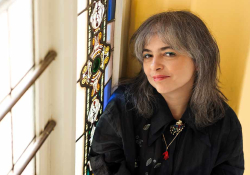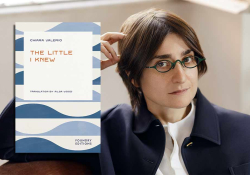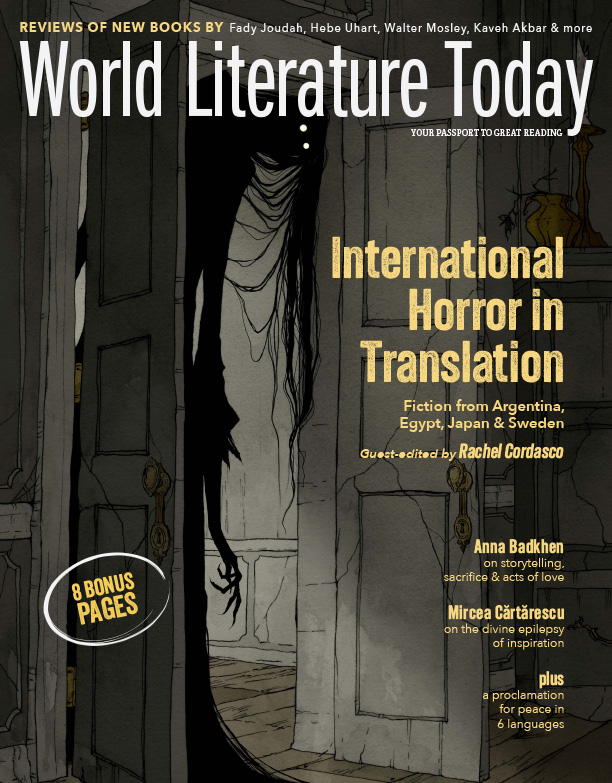A Feminist Tide in Latin America: Megan McDowell on the Argentine Movement of New Genre-bending Horror
 Megan McDowell is a leading English-language translator of fiction from Latin America. McDowell has worked with authors such as Samanta Schweblin and Mariana Enríquez, known for the use of bodily, personal, uncanny, and political elements.
Megan McDowell is a leading English-language translator of fiction from Latin America. McDowell has worked with authors such as Samanta Schweblin and Mariana Enríquez, known for the use of bodily, personal, uncanny, and political elements.
Agnethe Brounbjerg Bennedsgaard: The International Booker Prize has in the last decade started sharing prizes between translators and authors alike, as a way to highlight the irreplaceable role of translation. How do you think this reflects the development of recognizing the creative work of translators worldwide?
Megan McDowell: I think it’s done a great deal to support translators and their work, and it also does a lot in terms of promoting literature in translation overall. Sales of translated fiction have gone way up in the UK since 2016, when the Booker changed its rules to be awarded every year for a single work and to be split evenly between author and translator. I know prizes can be controversial and we can always question who makes the list and who doesn’t, but I think they are useful for giving readers a way into the literature of a country or language they may otherwise not be very familiar with. It’s a gateway drug—you read Tomb of Sand because it won the Booker, and then you’re on the lookout for other translations from Hindi because you have a little context, and you’ve had a good experience that you want to repeat.
I certainly didn’t get into translation thinking about prizes, but I do think that getting nominated or winning a prize can be validating for a translator. I remember feeling like I was toiling away in obscurity, and when Samanta and I were nominated for the Booker in 2017 it was shocking, and I realized that there actually were people paying attention. Gaining the respect of your peers is an important part of fulfillment for human beings, and for translators, who often have to fight just to get paid and who have a very precarious job that is often thought of more as a hobby, that kind of respect or recognition can change how you see what you do.
And there are other shifts toward recognizing translators—the National Book Award relaunched their translation category in 2019, and it’s the only one of their categories that doesn’t require applicants to be US citizens. The O. Henry Prize, as well, accepts translations as of 2022, with half of that year’s prizes going to stories in translation. I like to think that this is part of a larger and more general movement toward inclusivity and away from a conception of the US and the English language as the center of the world.
Brounbjerg Bennedsgaard: What do you think of the discussion about publishing houses who don’t put the names of translators on their book covers? I think the fact that you can even have that conversation about the fairness of the translator being on the covers shows a change in the conversation about translated literature.
McDowell: I think the #translatorsonthecover movement and the open letter by Jennifer Croft and Mark Haddon has really had an impact, and I’m so grateful to them. Translators have been working toward that symbolic recognition for a long time, but asking the writers to take a stand on the issue was a watershed. Alejandro Zambra, who is a great ally of translation, now includes a clause in his contracts stipulating that his translators’ names be included on the covers of his books in all languages. Not all publishers will accept the clause, but he will fight for it.
In general, I think this is a similar case to that of prizes. In the past, publishers wanted to hide the fact that a book was a translation; they had the idea that people would actively shun translation. But now readers are more engaged in international literature, they see translation as a pro and not a con, or else they see it as neutral, but certainly not a reason to avoid a book. Sometimes they’re even following certain translators and seeking out their work. The overall goal, though, is not just to give prominence to translators’ names and build them up. It’s to encourage people to read more in translation, and the translators-on-the-cover movement has to do with destigmatizing translation for readers—that’s the key.
Brounbjerg Bennedsgaard: Do you think translation is also a form of writing in itself? What are some of your tips for translating, which might also be translated into creative writing in general?
McDowell: I think there are overlapping skill sets for writing, translation, and criticism; there are also some major differences, which may be obvious but are still worth mentioning. As a translator I never have to face the empty page, and the empty page can be terrifying. The translator always starts with something. I do write the occasional thing, and every time I do, I remember why I’m not a writer—having to organize your thoughts can be overwhelming, at least to a brain like mine. Translation is more similar to reading in that sense—no matter how experimental the text, you always have something to follow along with line by line, you are led by the text. I think translators get to focus on the fun part of writing. It’s an active reading in which you get to participate in the text, solve puzzles in order to re-create it—I like to call it “creative reading.”
Another difference is that while Mariana Enríquez is the only person who can write a Mariana Enríquez story, I’m not the only person who can translate it. I’m the only person who will write a Megan McDowell translation, and I like to think a Megan McDowell translation is pretty good, but a Jane Doe translation might be better, and would definitely be different. Jane Doe would make different choices. Thinking about it this way may seem like I’m giving short shrift to the work of translation, but I’m not. There are multiple possible translators, but they are not infinite; in order to translate a given language or writer you need to have cultural and practical experience, plus knowledge and sensitivity, and yes, writing ability.
Translators are creative artists working within constraints.
Translators are creative artists working within constraints. A translator dedicates a significant part of her life to developing the skills to successfully or meaningfully communicate other people’s work, which requires another skill: empathy. In sum, I’m reluctant to say translators are just like writers because it implies that their work isn’t valuable unless they are authors. Their task is a different one, though symbiotic, and it has value and merit on its own terms.
In terms of skills that are transferrable to creative writing, I think there are several. For one thing, translation involves an endless amount of decision-making. I think a lot of times when we translate we get caught up in this idea that X is the translation of Y, and often when we start to translate we don’t question those dictionary-style definitions. But those automatic assumptions and associations can often mislead us, and so as a translator, I’ve developed an awareness of the decisions I make, and I’m always questioning them, thinking about what other possibilities exist, and trying to be aware of why I’ve chosen one word or phrasing over another. I need to know why each individual word is there, and I need to be aware of the music of all the words together—a micro- and macro-awareness that I’m sure serves writers as well.
Brounbjerg Bennedsgaard: You translate Latin American literature into English, so you’re very familiar with the Latin American literary landscape. In the days of the literary boom of Latin America, the English-speaking world got accustomed to a very specific idea of what Latin American literature was. I am of course referring to magical realism. How do you feel this expectation from an English-speaking readership has developed since you started translating? What has your experience with the publishing houses been like, as well as with readers, in terms of expectations toward the books coming out of Latin America? And how have the books you translate helped develop the ever-changing canon?
McDowell: It’s remarkable how difficult it is to get away from the Boom! If you’re talking about Latin American literature outside of Latin America, it’s only a matter of time before it comes up.
It’s important to remember that the Boom was a marketing construct, orchestrated largely by one person, the agent Carmen Balcells, and it excluded a lot of worthy authors. But beyond that, there was a certain sensibility that the Boom writers shared. They came from local traditions that tended toward realism and naturalism, and they all turned away from that and toward more experimental forms and fragmented styles that questioned linearity and solid literary voices. They also interrogated their own national identities while simultaneously conceiving of a larger Latin American identity. It’s no coincidence that many of the great works of the Boom were written by authors living outside their countries: Cortázar wrote Hopscotch in Paris, García Márquez wrote One Hundred Years of Solitude in México, José Donoso wrote The Obscene Bird of Night in Spain and the US, Vargas Llosa wrote The Time of the Hero in Paris, and so on. Magical realist writers are known for incorporating folklore, myths, and legends and often focusing on poor, rural settings and characters, but they had cosmopolitan, international sensibilities informed by international literary and artistic movements.
Bolaño, Knausgaard, and Ferrante are the trifecta that taught publishers that translation can be successful and profitable.
I think readers and editors know that there’s more to Latin American literature than the Boom and magical realism. For one thing, there are women writers! Lots of them! Editors are now on the lookout for them, and so are readers. There was also the post-Boom success of Roberto Bolaño, which I think set a lot of publishers looking for the next Bolaño in Latin America. Bolaño, Knausgaard, and Ferrante are the trifecta that taught publishers that translation can be successful and profitable. And so I think the large publishers are more open to translation these days, while there are also more small, independent presses specifically geared toward translation, and it all creates more of an ecosystem for translation to thrive. A big change since I first started translating is that it’s ever more common for a book to be published in Spanish and English almost simultaneously, or within a year or two. You also see more first-time or midcareer authors who are being translated, which I think is very important—translation can be a more immediate, ongoing conversation, which provides readers with more context for the work, and greater proximity to it.
Brounbjerg Bennedsgaard: In that regard, I see, especially in Samanta Schweblin and Mariana Enríquez, several of whose books you have translated, a kinship regarding both magical elements, horror elements, political and feminist themes. How do you view this connection? When you choose to take on a project, are connections or themes between earlier projects something that plays a part?
McDowell: As the translator of both Mariana and Samanta, I find it more useful to think about how they differ than how they’re similar. Yes, they’re both women from Argentina and work with less than realistic subject matter, and of course they’re informed by political and feminist throughlines. In terms of horror, Mariana works much more with genre tropes and recognizable gothic elements alongside Argentine myths and legends. Her fiction tends to be very tied to place—often Buenos Aires, or the north of Argentina near Paraguay. She builds up sensory details to create ambience and paint a picture, and she invokes fear with varying levels of terror, horror, and disgust—she is a visceral writer, and she tells you how things sound, feel, smell. And, of course, the supernatural plays a big role in a lot of her fiction—she is equally influenced by Guaraní mythology and by Lovecraft, and her fiction easily blends local legends and pop culture and the influence of a healthy dose of English-language writers, from Stephen King’s horror to Emily Brontë’s gothic literature.
As the translator of both Mariana and Samanta, I find it more useful to think about how they differ than how they’re similar.
Samanta, on the other hand, often works with settings that feel more mythological, isolated in time and space. She’s a psychological writer who guides her reader precisely, not through accumulation of detail but by showing you just what you need to know. And while there are supernatural elements at times, it’s often difficult to recognize just where the line between real and unreal is, and when we’ve crossed it. She’s just as likely to remain in the land of the uncanny real, where things are possible but unlikely. She’s a master of tension and has a finely honed ability to keep her readers in a state of suspenseful dread that shifts and changes but never abates.
When I think about taking on a new project, I just look for books that surprise me. I do tend to be drawn to certain things—I’ve always been a fan of horror, and I’m drawn to the reinvention of the genre that Mariana undertakes. I’m also drawn to experimentation and to any good story that surprises me, that subverts my expectations in large or small ways, that keeps me guessing the way Samanta’s stories do.
Brounbjerg Bennedsgaard: In most of Schweblin’s books, you generally don’t have any idea about where you are. But with Enríquez, you get the exact name of the city, even down to the neighborhood, it’s so tied to space. So, I’m interested in how you translate both the very specific places like in Enríquez’s books and then something like Schweblin’s nonplaces, places that neither you nor the reader know?
McDowell: Honestly, my approach isn’t all that different. I’m always trying to picture settings, to re-create spaces and the characters’ movement through them, and that’s true whether the space is an apartment interior, an imaginary nonplace, or a specific neighborhood or city. With Mariana, because her places tend to be “real,” I can often use Google to look up images and maps, but sometimes that isn’t helpful and I still need to ask questions. Both of them have had to send me pictures of houses, specific ones like the Cheyne Walk house in Our Share of Night, or just examples to show me the style of a house, like the green house where the healer woman lives in Fever Dream.
In general, my (impossible) goal is to have as much knowledge about the settings as the writers themselves have, so that I can communicate it as precisely as it needs to be communicated (though sometimes ambiguity is more important!). I remember asking Mariana a lot of questions about the layout of the Other Place in Our Share of Night, because she describes it in such detail but it’s all imaginary, and I wanted to get it just right—what was the passageway like that led into the Place? How exactly were the hands placed on the trees? Things like that.
I also remember that when the movie version of Fever Dream came out, which Samanta worked closely on with the director, Claudia Llosa, I was surprised by how much the movie looked like the images I’d had in my head while translating the book. I found that encouraging, like I’d managed to successfully imagine myself there.
Brounbjerg Bennedsgaard: Both writers have a very distinct tone. It’s sharp, precise, and extremely visceral. Enríquez once said in an interview, “The fact that in most of the world today we have the information to know about injustice and are powerless or, in most cases, careless about it, is a form of horror.” This horror of the everyday is very present in her stories. Think of how she uses a more magical horror, such as a zombielike figure that comes back to haunt in “Under the Black Water,” to mirror and emphasize the realistic horror of the everyday.
Schweblin has similarly stated that she reads a great deal of realism, because “if it’s realism you want to destroy, then it’s realism you have to write.” So, both authors balance the everyday and the horrific, the realistic and the otherworldly. Could you elaborate on how you approach this relationship between the levels of reality, which exist at the same time, in your translations?
McDowell: I’m not sure I can elaborate a particular strategy or method for dealing with levels of reality in translation, though I like the question and wish I could. I think you’re right that both Mariana and Samanta take on real-life subjects that are horrific but that we avoid thinking about, and make them feel immediate and urgent. Horror in general is a useful tool in that regard, and I think that’s one of the reasons we’re seeing such a surge in it these days. Racism is a social ill that plagues the US, but some people refuse to recognize it, and a movie like Get Out can make us (all of us) feel the true horror of it in a visceral way. That’s what Mariana does with the violence of the Argentine dictatorship in much of her work, or with police violence in “Under the Black Water”; it’s what Samanta does with pesticide use and the environment in Fever Dream. All these social ills make us feel helpless and out of control, and we often turn away from it. Stories like Mariana’s and Samanta’s make us confront the horror and feel it in our bodies.
Racism is a social ill that plagues the US, but some people refuse to recognize it, and a movie like Get Out can make us (all of us) feel the true horror of it in a visceral way.
Brounbjerg Bennedsgaard: This makes me think of the tension that Schweblin creates in Fever Dream, by combining motherhood, which is so intimate, and then climate change, which is so global. You can’t protect your child if the environment the child lives in is already poisoned, and that’s a terrible thing to realize. But the tension is perhaps also created through the ambivalence of the boy in this story, David, who is framed as a monster. After he was poisoned by pesticides in the soy fields, his mother takes him to a local witch who performs transmigration of souls. His soul was taken into a healthy body, and another soul was put into his sick body. And it’s never confirmed whether this happened or not, but he’s a character that Amanda, the other main character, and the others fear. How do you view this tension?
McDowell: I see David not necessarily as a monster but as a person who knows something no one else does. He has an ability that makes him seem sinister—that of helping living beings cross over to whatever comes next—but I think of him as a force for good, when it comes down to it. I think a lot of the horror here comes from the knowledge that you can never fully protect your child from the evils of the world—which these days often means environmental disaster—even if you’re right next to them. Also, you can never truly know them, which is scary because they came from you. They are separate from you, and that’s terrifying because you want to both protect them and control them (which are often the same thing).
I think a lot of the horror here comes from the knowledge that you can never fully protect your child from the evils of the world—which these days often means environmental disaster—even if you’re right next to them.
In general, “tension” is a good word. I think Samanta has a remarkable talent for creating tension from the very start and never letting it go slack, and that’s really on display in Fever Dream (the story “An Unlucky Man” is another great example). And a lot of that comes from the voices here, the conversational form of the book. There’s always another question, another answer that’s just out of reach, and we’re pulled along in the search to reach that “important thing,” that unifying truth that gives meaning.
May 2023
Editorial note: For more, read Veronica Esposito’s 2020 interview with McDowell and her essay “The New Cadre of Latin American Women Writers” in the March 2023 issue of WLT.












